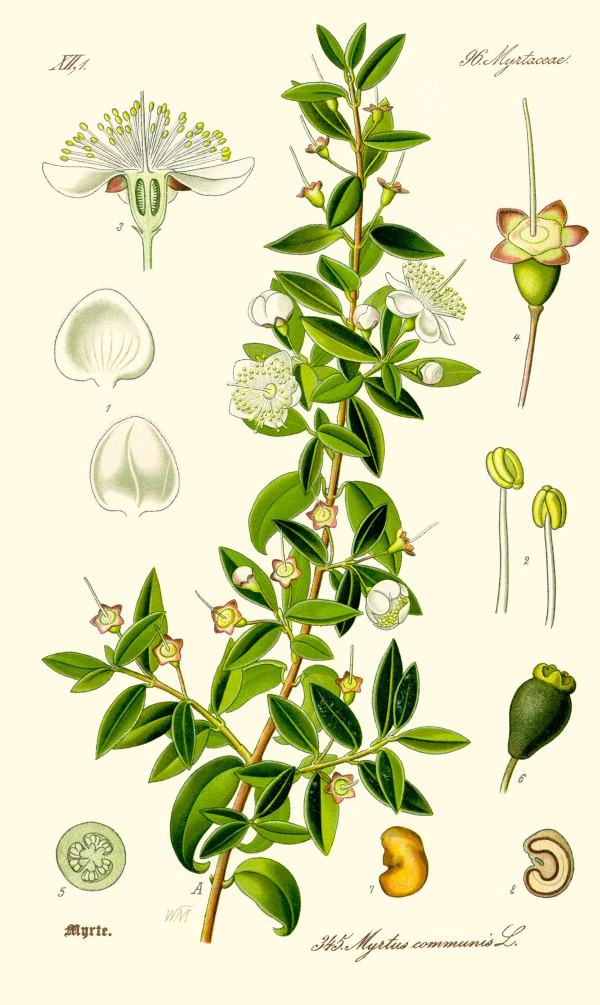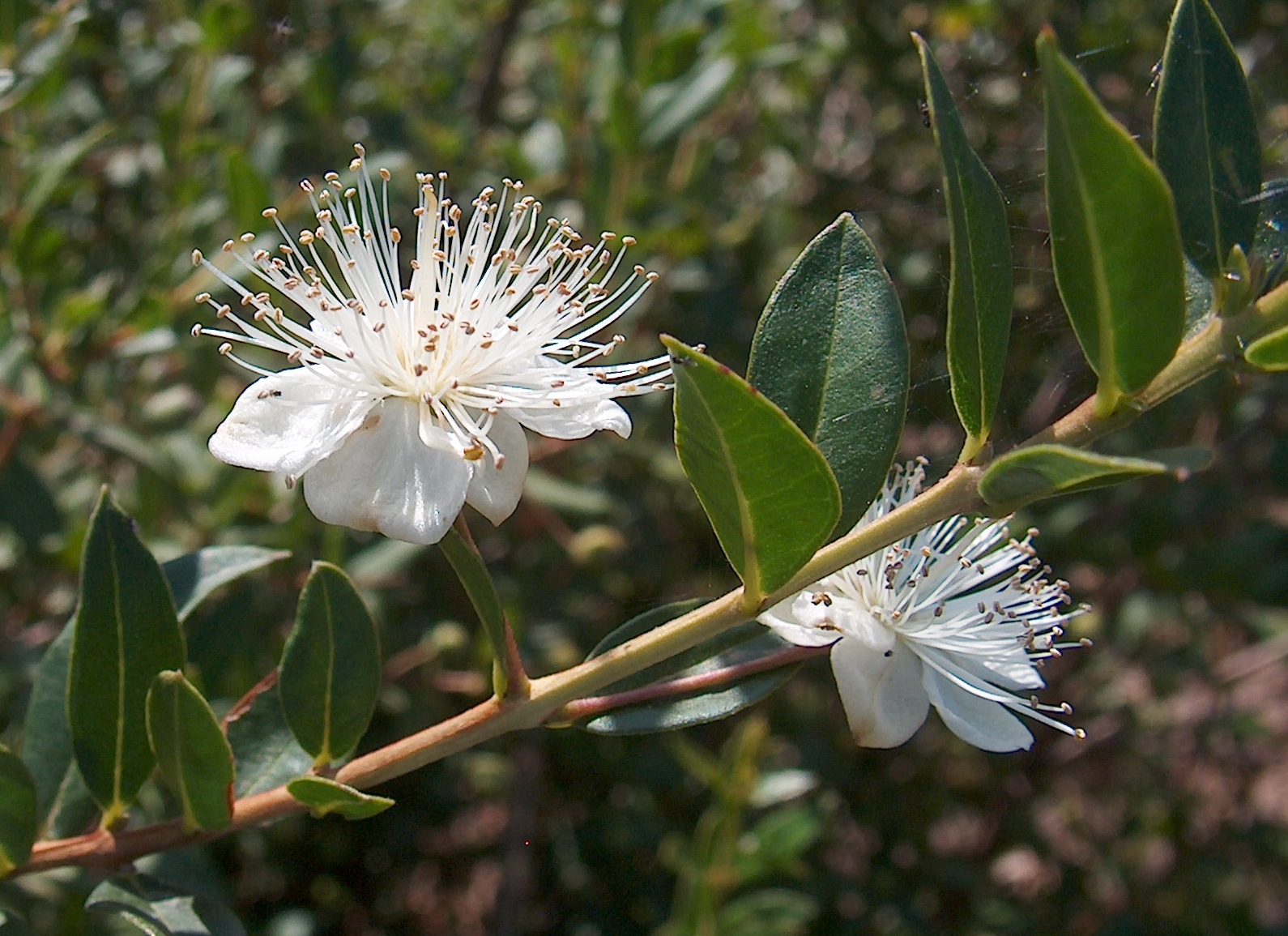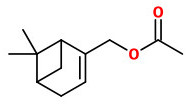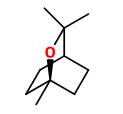Myrtus communis L. - Myrtaceae - common myrtle, true myrtle, Gemeine Myrte, Brautmyrte
Evergreen shrub or small tree, up to 5 m tall, native to the Mediterranean region, naturalized and cultivated elsewhere; leaves short petioled, entire, ovate-lanceolate, fragrant (oil dots); flowers white.
„The distribution area includes the Mediterranean, the Canary Islands and extends east to central Asia… The myrtle is cultivated since ancient times and is often neglected accordingly.“ http://de.wikipedia.org/wiki/Myrte
„The chemical composition of the essential oils obtained by hydrodistillation of Spanish cultivated and wild growing plants from Myrtus communis L. was examined by GC/MS. Over one hundred compounds were detected in the oils, from which about fifty could be identified and quantified. The main components were found to be α-pinene (8.05-8.18%), 1,8-cineole (15.14-29.89%), linalool (0.5-8.3%), and myrtenyl acetate (32.90-35.90%). A myrtle oil of Moroccan and one of Albanian origin were also examined and their composition was compared against the lab-distilled oils from Spanish plant material. The major components of these oils were α-pinene (19.40-23.54%), limonene (10.94-12.37%), 1,8-cineole (21.77-33.63%), and myrtenyl acetate (16.06-16.08%).“
[The Chemical Composition of Spanish Myrtle Leaf Oils. Part I. Boelens, Mans H., and Rafael Jimenez. Journal of essential oil Research Vol.3 (3), 1991, 173-177]
„The chemical compositions of 15 commercial samples of essential oils of leaves of Myrtus communis L. from five different Mediterranean locations (Corsica, Morocco, Tunisia, Lebanon, and former Yugoslavia) were studied. Forty-seven compounds were identified by GC/MS. They could be divided into two groups on the basis of their percentages of α-pinene; over 50% (Corsica and Tunisia), and under 35% (the others). The percentages of limonene, 1,8-cineole and myrtenyl acetate were consistent with this classification. The chemical compositions of these oils can be compared to those of Spanish oils.“
[Essential oils of myrtle (Myrtus communis L.) of the Mediterranean littoral. Chalchat, Jean-Claude, Raymond-Philippe Garry, and André Michet. Journal of essential oil Research, Vol.10 (6),1998, 613-617]
„The content and composition variations of the leaf, flower and fruit oils of Myrtus communis L. were studied during a one-year vegetative cycle. The plant material was harvested from the ecologically pure area on the island of Vis (Croatia). Yield and composition of myrtle oils depended on collected plant parts and on the period of harvest. Myrtenyl acetate (13.5-30.7%), 1,8-cineole + limonene (12.6-29.8%), linalool (10.8-18.3%) and α-pinene (6.6-16.4%) were five predominant terpenoid compounds in myrtle leaf oils. These compounds were also detected in the flower and fruit oils, but in different proportions. The fruit and flower oils always contained less linalool than leaf oils. During the collecting period the oil yields (w/w) varied as follows: leaf oils (0.19-0.37%), flower oils (0.21-0.26%) and fruit oils (0.03-0.13%).“
[Comparative study of leaf, fruit and flower essential oils of Croatian Myrtus communis (L.) during a one-year vegetative cycle. Jerkovic, Igor, Ani Radonic, and Ivo Borcic. Journal of Essential Oil Research Vol.14 (4), 2002, 266-270]
„The chemical composition of the volatile fraction of myrtle (Myrtus communis L.) alcoholic extracts and essential oils from leaves and berries collected in different places in Sardinia (Italy) was studied… Strong chemical variability depending on the origin of the samples was observed. The major compounds in the essential oils were α-pinene (30.0 and 28.5%), 1,8-cineole (28.8 and 15.3%), and limonene (17.5 and 24.1%) in leaves and berries, respectively, and were characterized by the lack of myrtenyl acetate.“
[Chemical composition of volatiles in Sardinian myrtle (Myrtus communis L.) alcoholic extracts and essential oils. Tuberoso, Carlo IG, et al. Journal of agricultural and food chemistry, Vol.54 (4), 2006, 1420-1426]
„The chemical composition of 27 oil samples of Myrtus communis isolated from leaves collected in three locations in north-eastern Algeria was investigated by GC(RI) and 13C NMR spectroscopy. Yields ranged between 0.2-1.2% (w/w). The chemical composition of the oils was largely dominated by monoterpene hydrocarbons, with alpha-pinene (40.5-64.0%), 1,8-cineole (10.9-29.1%) and limonene (6.7-8.2%) being the major compounds. In all the samples, 3,3,5,5,8,8-hexamethyl-7-oxabicyclo[4.3.0]non-1(6)-ene-2,4-dione was identified (0.8-1.5%). The composition is similar to that reported for myrtle oils from Corsica, Sardinia and Tunisia, but differed from that of Moroccan and Spanish myrtle oils.“
[Composition and chemical variability of leaf oil of Myrtus communis from north-eastern Algeria. Bouzabata, Amel, et al. Natural product communications Vol5 (10), 2010, 1659-1662]
Main components of two M.communis essential oil samples from Montenegro were α-pinene (14.7% S1; 35.9% S2), 1,8-cineole (25.7% S1; 23.9% S2), linalool (10.1% S1; 10.9% S2) and myrtenyl acetate (5.4% S2; 21.6% S1).
[Mimica-Dukić, Neda, et al. „Essential oil of Myrtus communis L. as a potential antioxidant and antimutagenic agents.“ Molecules 15.4 (2010): 2759-2770] https://res.mdpi.com/molecules/molecules-15-02759/article_deploy/molecules-15-02759-v2.pdf?filename=&attachment=1
Main compounds of 33 Myrtus communis L. oil samples of from Morocco were α-pinene (6.4-51.7%), limonene (2.8-13.9%), 1,8-cineole (2.5-45.7%), linalool (0.9-22.1%), α-terpineole (0.5-4.8%), myrtenol (0.1-2.6%), myrtenyl acetate (0.1-44.4%), α-terpinyl acetate (0.4.8%), geranyl acetate (1.1-10.9%), and methyleugenol (0.6-5.3%). Minor components were e.g. myrtenal, 2/3-methylbutyl-esters of 2/3-methylbutyrate, methyl myrtenate and methyl geranate, and alcohols like pinocarveol, nerol and geraniol.
[Bakhy, Khadija, et al. „Chemical variability of Moroccan myrtle oil.“ Chemistry & Biodiversity 18.9 (2021): e2100209]
„In vitro experimental results seem to confirm historical data on the ability of myrtle essential oil to exert anti-inflammatory and mucolytic actions on the upper airway epithelium and are supported by morphological analyses of samples by light and electron microscopy. The mechanism of action remains to be determined but might include activation of epithelial cells and subsequent recovery from inflammation and restitutio ad integrum.“
[Therapeutic properties of myrtle essential oil: an in vitro study on human nasal mucosa cells., Fenu, G., Foddai, M., Carai, A., Pirino, A., Usai, M., International Journal of Essential Oil Therapeutics, 2(1), 2008, 21-25]
„The methanol, ethanol, and ethyl acetate extracts of Myrtus communis leaves and berries were examined for in vitro antibacterial activity. The methanolic leaf extract of M. communis, which was seen to have antibacterial activity against Listeria monocytogenes CECT 4032 and Pseudomonas aeruginosa IH, was further investigated to determine the effect of the extract on viable counts of bacteria using the bacterial cell-death time. Most of the extracts showed relatively high antibacterial activity against most of the tested microorganisms. None of the extracts was active against Escherichia coli K12. The results obtained confirm the antibacterial potential of the extracts of M. communis.“
[Antibacterial activity of extracts of Myrtus communis against food-borne pathogenic and spoilage bacteria., Amensour, M., Bouhdid, S., Fernandez-Lopez, J., Idaomar, M., Senhaji, N.S., Abrini, J., International Journal of Food Properties, 13(6), 2010, 1215-1224]
Myrtle leaves contain myrtucommulones, which are pharmacologically interesting compounds with antibacterial, analgesic, and strong anti-inflammatory effects. The acylphloroglucinol myrtucommulone A causes mitochondrial dysfunctions by direct interference leading to apoptosis in cancer cells. The chaperonin heat-shock protein 60 (HSP60) has been found as a molecular target. Inhibition of HSP60 by myrtucommulone correlates to Lon protease-like protein (LONP) and leucine-rich PPR motif-containing protein (LRP130) aggregation.
[Wiechmann, Katja, et al. „Mitochondrial Chaperonin HSP60 Is the Apoptosis-Related Target for Myrtucommulone.“ Cell Chemical Biology 24.5 (2017): 614-623]

Thomé,O.W., Flora von Deutschland Österreich und der Schweiz, Tafeln, vol.3 t.345 (1885)
http://plantgenera.org/species.php?id_species=689361

Myrtle (Myrtus communis L.) in second flowering (2005)
Professional Institute of Agriculture and Environment „Cettolini“ of Cagliari (Sardinia, Italy)
CC BY-SA 3.0, Author: Giancarlo Dessì Wikimedia Commons




